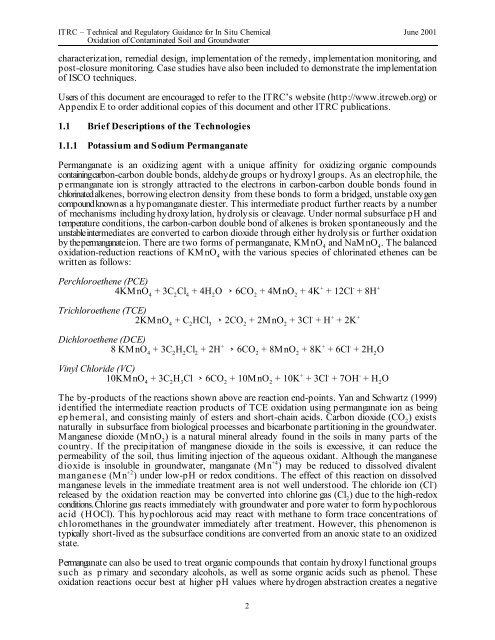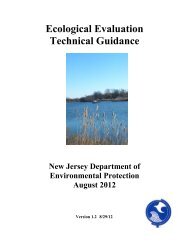Technical and Regulatory Guidance for In Situ Chemical ... - ITRC
Technical and Regulatory Guidance for In Situ Chemical ... - ITRC
Technical and Regulatory Guidance for In Situ Chemical ... - ITRC
You also want an ePaper? Increase the reach of your titles
YUMPU automatically turns print PDFs into web optimized ePapers that Google loves.
<strong>ITRC</strong> – <strong>Technical</strong> <strong>and</strong> <strong>Regulatory</strong> <strong>Guidance</strong> <strong>for</strong> <strong>In</strong> <strong>Situ</strong> <strong>Chemical</strong> June 2001<br />
Oxidation of Contaminated Soil <strong>and</strong> Groundwater<br />
characterization, remedial design, implementation of the remedy, implementation monitoring, <strong>and</strong><br />
post-closure monitoring. Case studies have also been included to demonstrate the implementation<br />
of ISCO techniques.<br />
Users of this document are encouraged to refer to the <strong>ITRC</strong>’s website (http://www.itrcweb.org) or<br />
Appendix E to order additional copies of this document <strong>and</strong> other <strong>ITRC</strong> publications.<br />
1.1 Brief Descriptions of the Technologies<br />
1.1.1 Potassium <strong>and</strong> Sodium Permanganate<br />
Permanganate is an oxidizing agent with a unique affinity <strong>for</strong> oxidizing organic compounds<br />
containing carbon-carbon double bonds, aldehyde groups or hydroxyl groups. As an electrophile, the<br />
p ermanganate ion is strongly attracted to the electrons in carbon-carbon double bonds found in<br />
chlorinated alkenes, borrowing electron density from these bonds to <strong>for</strong>m a bridged, unstable oxygen<br />
compound known as a hypomanganate diester. This intermediate product further reacts by a number<br />
of mechanisms including hydroxylation, hydrolysis or cleavage. Under normal subsurface pH <strong>and</strong><br />
temperature conditions, the carbon-carbon double bond of alkenes is broken spontaneously <strong>and</strong> the<br />
unstable intermediates are converted to carbon dioxide through either hydrolysis or further oxidation<br />
by the permanganate ion. There are two <strong>for</strong>ms of permanganate, KMnO <strong>and</strong> NaMnO . The balanced<br />
4 4<br />
oxidation-reduction reactions of KMnO with the various species of chlorinated ethenes can be<br />
4<br />
written as follows:<br />
Perchloroethene (PCE)<br />
4KMnO<br />
4<br />
+ 3C2Cl 4<br />
+ 4H2O ÷ 6CO<br />
2<br />
+ 4MnO<br />
2<br />
+ 4K + 12Cl + 8H<br />
+ - +<br />
Trichloroethene (TCE)<br />
2KMnO<br />
4<br />
+ C2HCl 3<br />
÷ 2CO<br />
2<br />
+ 2MnO<br />
2<br />
+ 3Cl + H + 2K<br />
- + +<br />
Dichloroethene (DCE)<br />
+ + -<br />
8 KMnO<br />
4<br />
+ 3C2H2Cl 2<br />
+ 2H ÷ 6CO<br />
2<br />
+ 8MnO<br />
2<br />
+ 8K + 6Cl + 2H2O<br />
Vinyl Chloride (VC)<br />
+ - -<br />
10KMnO<br />
4<br />
+ 3C2H3Cl ÷ 6CO<br />
2<br />
+ 10MnO<br />
2<br />
+ 10K + 3Cl + 7OH + H2O<br />
The by-products of the reactions shown above are reaction end-points. Yan <strong>and</strong> Schwartz (1999)<br />
identified the intermediate reaction products of TCE oxidation using permanganate ion as being<br />
ep hemeral, <strong>and</strong> consisting mainly of esters <strong>and</strong> short-chain acids. Carbon dioxide (CO ) exists<br />
2<br />
naturally in subsurface from biological processes <strong>and</strong> bicarbonate partitioning in the groundwater.<br />
Manganese dioxide (MnO<br />
2) is a natural mineral already found in the soils in many parts of the<br />
country. If the precipitation of manganese dioxide in the soils is excessive, it can reduce the<br />
permeability of the soil, thus limiting injection of the aqueous oxidant. Although the manganese<br />
+4<br />
dioxide is insoluble in groundwater, manganate (Mn ) may be reduced to dissolved divalent<br />
+2<br />
manganese (Mn ) under low-pH or redox conditions. The effect of this reaction on dissolved<br />
manganese levels in the immediate treatment area is not well understood. The chloride ion (Cl - )<br />
released by the oxidation reaction may be converted into chlorine gas (Cl<br />
2) due to the high-redox<br />
conditions. Chlorine gas reacts immediately with groundwater <strong>and</strong> pore water to <strong>for</strong>m hypochlorous<br />
acid (HOCl). This hypochlorous acid may react with methane to <strong>for</strong>m trace concentrations of<br />
chloromethanes in the groundwater immediately after treatment. However, this phenomenon is<br />
typically short-lived as the subsurface conditions are converted from an anoxic state to an oxidized<br />
state.<br />
Permanganate can also be used to treat organic compounds that contain hydroxyl functional groups<br />
such as p rimary <strong>and</strong> secondary alcohols, as well as some organic acids such as phenol. These<br />
oxidation reactions occur best at higher pH values where hydrogen abstraction creates a negative<br />
2
















